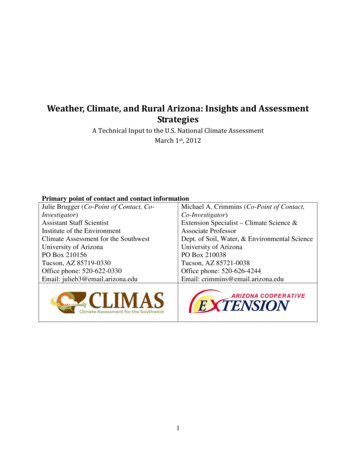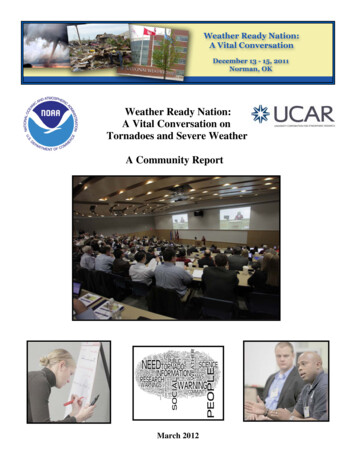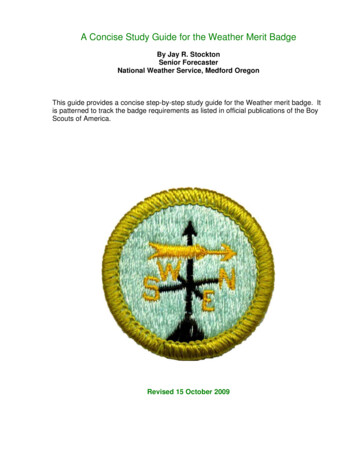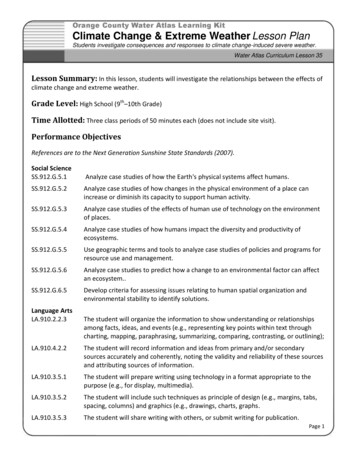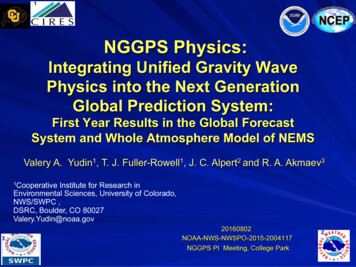
Transcription
1NGGPS Physics:Integrating Unified Gravity WavePhysics into the Next GenerationGlobal Prediction System:First Year Results in the Global ForecastSystem and Whole Atmosphere Model of NEMSValery A. Yudin1, T. J. Fuller-Rowell1, J. C. Alpert2 and R. A. Akmaev31CooperativeInstitute for Research inEnvironmental Sciences, University of Colorado,NWS/SWPC ,DSRC, Boulder, CO 2015-2004117NGGPS PI Meeting, College Park22
of Yr-1:
The R2O/NWS transforms andupgrades the operational GFS intothe Unified Global Model withinNEMS framework.The first vert. extended GFS (fromthe current 64L to 91L) promises toimprove the stratospheric forecastsand the trop-stratosphere coupling.For vertically extended models, ourcurrent aim is to unify the GFS-91L(lid 80km) and the 150L WholeAtmosphere Model (WAM-150L, 500 km) under the Global SpectralModel (GSMe) of NEMS in 2016-17.Unification and upgrades of GFSand WAM physics will streamline Dynamics and physics of resolved and sub-gridthe interaction of analysis and quasi-stationary Orographic GWs (OGWs) andforecast for terrestrial and space Non-stationary GWs (NGWs) represent the majorweather and climate predictions uncertainties for extended models of NEMS.under NEMS/NGGPS frameworkR2O/UGW project “unifies” GW physics.
Gravity Wave Hotspots/Sources from Satellites:AIRS, COSMIC, HIRDLS & SABER Hindley et al, 2015Gong et al., 2012COSMICHIRDLS, Aug 2006AIRS-EastAIRS-WestConv viewOro-AndesFronts/jetsSH ORO-GW metricsErn et al, 2011Jan 35 kmJul 35 kmHIRDLSJan 55 kmJul 55 kmSABER, 30 km
Unified GW physics in the NCEP models:GFS, NEMS-GSM and NEMS-WAMSpecfic R2O Goals:(1) Perform “orchestration” of the GWsolvers for all types of wave sources(orography, convections, front, jets, andother imbalanced dynamics) ; samebreaking criteria and dissipation.(2) Create portable and adaptable to the typeof parameterization “GW-unified” modulewith 3 stages: Init - Advance - Diagnose.(3) Allow both stochastic and deterministicperformance of GW schemes (sources,spectra, and triggers).Unified GW Physics ModuleINIT: GW NML, choice ofGW sources and solversADVANCE: Drag, Heat, Keddyevery time-step or 1-hr cadenceData-driven Diagnostics:dominant wavelengths, energy,momentum and heat fluxes.GW-sources: NRL, GMAO, ECMWF,NCEP and NCAR;(4) Explore novel observational GW metrics/ GW-solvers : operational weather andconstraints for “resolved” and sub-grid GWs climate schemes with adapts for:(a) energy-balanced formulations:(5) Introduce GW effects (drag, heat & eddies) (b) eddy diffusion and mass fluxes andself-cons. heat-drag-K;in the self-consistent, energy-balanced(c) resolution-sensitive specificationsand resolution-aware formulations;of parameters.orchestrate strengths of GW-drag, eddiesand Rayleigh friction and “spectral” damping.
Diagnostics of GW-forcing: non-stationary GWs in JulyNOAA-CIRES scheme, implemented in WAM-NEMSGW wind rmsEddy mixing, Kzz, dueto GW instabilityGWspectrumIn East -Westdirections ofphase velties-50(E)GW drag, momentumtendencies, m/s/dayMean Zonal Wind, m/s20 modesIn eachdirectionCh, m/s 50(W)WestwardEastwardGW vertical momentumfluxesGW heating, K/s/dayMean Temp-re, K, JulyGW accelerations of zonal winds
Resolving “GW-mesoscale” by Dycores: Kinetic Energy Spectra (KES)from Skamarock et al. (2014), MPAS with GFS-ICs, andKES from NOAA forecasts & analysisDissipativemesoscale rangeneeds for GW physicsMPAS correct it(GFS-ICs) in 18 hrsT256T382DivergernceMPAS and FV3 are two dycoresselected for NGGPS and finaldecision in Aug of 2016.T574Analysis(GDAS) shows enhancedGDAS mesoscale variations ofdivergence, noise or data signal?
“Placing” non-st. GW schemes in the chain of NEMS (NUOPC)physics of Global Atmosphere Models (WAM & GSM)Call ofWAM Sub-gridGW PhysicsCall ofGSM/GFS Sub-gridGW physics
Specifics of Vertically Extended Configuration of NEMS,GFS/GSM-91L: GW Physics in the Strato-Mesosphereq Vertical levels of GFS/GSM-91L followIFS-91L of ECMWF and resembleGEOS-5 (72L) of GMAO (TL 80 km);Decreased ( 3-times) Rayleigh frictionabove 70 km with inv. scale 15 days.q Previous (IFS, NOGAPS, GMAO)choices for GW intensity at 700 hPa(or at 500 hPa) to replicate latitudinaland seasonal GW activity from data.q Adapted GW solvers: (a) Linearsaturation with dis-n; (b) IFS-2000 withdis-n; (c) DSP-Hines’ with dis-n andnonlinear saturation; (d) Alexander &Dunkerton-99 with dissipation.q GW physics acts every time-step: fourazimuths and tested for T62 .- .T670q In progress: online diagnostics and eddymixing; other GW “candidates”; addingnon-LTE radiation of WAM for GSM;tests for oper. res-n at T1574 ( 13km)
Non-stationary sub-grid Gravity Wave (NGW) Physicsin Climate and Weather ModelsModel Climate/WeatherLevels & Top Lid GW-NSTschemeGWsourcesGW- GWdrag heatGWeddyWACCM &WACCM-XNCAR68 L (88L) 140 km (500km)Lin. Saturation(65 x 2 , 0.04 hPa ,Lin. Sat . with70km; (0.001 hPa stochastic 100 km)triiggers ( 1-4)Lat-timedepend.YYY?IFS-40R1/ECMWF91L (137L),0.01hPa , 80 km.Univer. Lin. Sat. Lat-depend.(25 x4 modes)YY?NoGEOS-5/GMAO/ 72L, 0.01 hPa,GSFC 80 kmNCAR schemewith reduced #of GW modes.Lat-depend.YYNoGFS/NCEP-91LLin. Sat(25 x4 modes)Lat-depend.YYNoLin. Sat(25 x4 modes)Lat-depend.YYY91L, 0.01 hPa, 80 kmWAM/NCEP-CU 150L (T62) 500 km
June 2014: GFS-forecast in 64L & 91L modelswith Rayleigh Frictions (RF) and physics of NGWsRole of RF (wind damping), itattempts to resolve 2 issues:GFS-64L(1) The top lid model effects,sponge layer to suppressresolved wave reflections;(GFS-64L); extra-heating;GFS-RF(2) The winter-summer zonal winddrag in the strato-mesosphere.Issues with RF-schemes:- erroneous reflections of PWs;-absence of the U-wind reversalsabove 70-80 km;-warm mesosphere relative to EOSAura MLS and TIMED-SABERmulti-year observations.Advantage of GW-physics:handle “above-listed” GFS-biases;consistency with the data.GFS-GWMLS-data20-day GFS forecasts from June 1 of 2014vs MLS-Aura 2014-06-30 (mean temperatures)
2014 GFS-T574 forecasts in 91L model with GW sources:Jan (15 day, right ) and Jun (25 day, left)GFS- ‐91LwithGWphysicsandGEOS- ‐5analysisSensi&vityofGFS- ‐91Lrunstospecifica&onofGW- ‐sources:constant,&me- ‐latdependen &la&tude- ‐onlydep- ‐nt
GFS- ‐91L(T670)10- ‐20- ‐30dayforecastsvsMLS- ‐AuraandGEOS- ‐510- ‐day20- ‐dayGFS- EOS- ‐5analysis30- ‐dayGFS- ‐91L800- ‐hrforecastWT:4hr48minRFWT:5hr57minGW- ‐40EOS- ‐AuraMLS- ‐V4.3June2014GEOS- ‐5Analysis,June2014
The 10 hPa ( 30 km) Forecasts of the South Ocean Windsby GFS-64L, GFS-91L and GDAS-analysis, June 2014GFS-64LGFS-91LJune2014GDAS5-day fst20-day fst5-day fst20-day fst
Enhanced resolution of GFS-91L(75 km 34 km) may better fitGDAS Vorticity and the filamentshapes after 20-days over theSouth Ocean and Antarctica at 24 km (50 hPa)T254T254T382T574GDAST382T574GDAS20-day FSTs &5-day FSTs &AnalysisAnalysisPV-filaments, desirable feature for forecasts of theozone transport and polar stratospheric chemistry
NEMS-GSM, 64L & 91L during SSW pulsations of 2016(01/25 –02/20) vs GDAS-NCEP & GEOS-5/GMAO analysesThe 6-hr separated polar (75-85N) zonal meantemperatures and the high latitude (55-65N)zonal mean winds during the minor SuddenStratospheric Warming (SSW) pulsations,Feb 2; GFS-91L with GWP tends to predictthe wind reversals in upper layers andtemperature-wind variations.The top rows (a-b) display temporalvariations deduced from GDAS (64L,T1534) and GEOS-5 (72L, 1/8 deg);The bottom (c-d): GSM/GFS forecasts atT670 with 64L (c) and 91L (d).
Integrating Unified Gravity Wave Physics intothe Next Generation Global Prediction System Summary of the 1-year resultsGW physics in NEMS-WAM improved zonalmean flows, planetary waves and tides.GW physics in GFS-91L brought a realism in thestratospheric dynamics during winters andwinter-to-spring transitions comparing to theRayleigh Friction simulations.GDAS/NCEPGFS-91L ForecastGEOS-5/GMAOSABER-dataTransition to NOAA operations,climate tests, and future plansa) Analysis-Forecast Cycling with GFS-90L ( 80km top) with “parallel” operational scripts; testsduring SSW events (2009, 2013, & 2016).b) NEMS-WAM multi-year climate runs for selfgenerated equatorial oscillations (QBO and SAO).c) New related projects: Assimilation of middleatmosphere O3, H2O and T-re profiles (MLS &SABER) to properly initialize NGGPS forecasts.ECMWF-DASMLS-dataJan-Feb 2016: GFS-91L 25-day polar temperatureforecasts (d), SABER (e) & MLS (f) data (left), andNWP analyses (right column) : GDAS-NCEP (a),17GEOS5-GMAO (b) and IFS-ECMWF(c).
WAM-trunk, no NGW Physics in the Strato-Mesosphereand Thermosphere, vs NOGAPS, UARS and MERRAWAM Trunk Run:WAM-NEMS, January(left, top) no NGW physicsNOGAPS-Alpha, Jan 2009with DA of SABER andMLS (right, top)UARS-SPARC windclimatology (1992-97)(HRDI-WINDII) UKMOMERRA-V1/GMAOJan 2009 (right, bottom).Biases above 40 km:-No MLT wind reversalsCold T-bias at 90-110 km.Strong strato-meso winds.Errors in PWs and Tides.
WAM-150L as Vertically Extended Atm-re Model of NEMS:specifics of Physics in the Mesosphere and Thermosphereq WAM, 150 vertical levels with top lidat 500-600 km; “Zero” Rayleighdamping with molecular visc./condand 4-th order spectral diffusion.q EUV and non-LTE radiation, iondrag, Joule heating, molecularprocesses, major tracer (O-O2N2)transport-diffusion-chem, &variable “g-Cp-R” (enthalpy).q WAM-T62 as development runs withEulerian dynamical core enhancedres-ns T254,T382; uniform NGWtriggers, 700 hPa.q GW solvers with molecular dis-n:GW drag, heat & mixing: 4-8azimuths; stochastic (random draw ofsingle wave) and deterministic spectra(10-20 modes per azimuth) for thelinear saturation schemes.
Role of Realistic Zonal Mean Flows in SW2 Tidal Predictionsfor “JJA” by NEMS-WAM with GW Physics (GWP)Akmaev et al., 2008, WAM no GWPMinMaxForbes et al., 2008AveMin40-50oSWAM with GWPWAM no GWP40-50oS45oSWAM no GWP45oSURAP: UARS Ref. Atm-reWAM with GWP45oS
Towards Assimilation of the Space-Borne MLT winds:Outlook for Analysis of WINDII/UARS Data in NEMS-WAMUARS, V-wind, 1993-94NEMS-WAM, T254, Mar 8WINDII - thickWAM-thinDominant structures of the 24-hr tidein the tropical MLT, lz 25 kmseen in UARS data and WAM.
Integrating Unified Gravity Wave Physics intothe Next Generation Global Prediction SystemTimothy Fuller-Rowell and Valery Yudin, CU-CIRES As R2O NGGPS effort, this project implementedthe non-stationary Gravity Wave (GW) schemes inNOAA weather and climate predictions system, GFSand NEMS to extend them above 50 km andimprove vertical atmosphere coupling, annual andsub-seasonal variations. Expected outcome: improvement of forecast skillsfrom the surface to the thermosphere for timewindows from 2 weeks to 1mth by adding physicsof GWs for unresolved momentum, heat and energydepositions. Deliverables: GFS-91L, WAM-150Lwith GW physics Connection to NGGPS: Development and implementation ofUnified Sub-Grid scale Gravity Wave (GW) physics in thevertically extended global atmosphere models of NGGPSthat resolve upper stratosphere and mesosphere for the terrestrialweather and climate predictions (NEMS-GFS/GSM 90 level, 80 km lid) and space weather predictions (NEMS-WAM, 150levels, 500 km top lid).UnresolvedmesoscaleGW-subrange-log(S(k)) 5/3Kinetic Energy Spectra S(k)R2O NEMS-WAM wind with GWPUARS climate, Zonal wind at 45oSCurrent NEMS-WAM wind, no GWP22
Key future elements of Unified GW physics in theextended atmosphere NOAA models:GFS/GSM-91L and WAM-150L1. GW Sources: Stochastic and physics-basedmechanisms for GW-excitations in the loweratmosphere, calibrated by the high-res runsanalyses, and observations (3 types of GWsources: orography, convection, fronts/jets).2. GW Propagation: Unified solver for“propagation, dissipation and breaking” ofwaves excited from all type of GW sources.3. GW Effects: Unified representation GWimpacts on the ‘resolved-scale’ flow for alltypes of GWs (energy-balanced parameterizations of momentum, heat, depositions and eddy mixing).4. Resolution-awareness of sub-grid GWschemes in all aspects of wave physics(sources, propagation, dissipation, effectson the resolved-scale flow).F-J ConvF-JHIRDLS Aug 2006ConvdxOroFronts/JetsGW Momentum Flux:Fuw U’W’ -LZ U’2 /LXLx (1-3) dxdx – typical size of the H-gridFuw 1/ dx, Fuw (T62) Fuw (T670)But U’2(T62) U’2(T670) 23
Summary and what will be next in 2016-17 and beyondThe unified GW physics package (momentum/drag, energy/heat, and mixing) for OGW andNGW was developed. Its implementations inGFS-91L show better skills in the servicewindows 6-10 days and 2-4 weeks in thestratosphere. As expected, extended models mayimprove winter predictions of SSW, NAO andAO patterns.For “dissipative” atmosphere four candidates forGW solvers are now adapted and evaluated inWAM. WAM-GW simulations displayimproved dynamics above 40 km: MF, PWsand Tides.Next, select “primary” NGW scheme forNEMS/GSM-91L, commit it in Sep/Oct 2016with GW physics extended for WAM-150L.Test GW physics package in the Research-2Operation NOAA Global Models (GFS-T1574,GSM-T1574 ) between Sep/16- Apr/2017.Long- ‐TermplansforNGGPSGWphysicsQBOinNEMSStochastic GW physics and wave triggers: rolein the ensemble spread & bias corrections in theupper layers for temperature and winds.F- ‐JConvF- ‐JF- ‐JConvF- ‐J
Sensitivity GFS-91GW to horizontal resolutionsT670 ( 30km)T574 (35km)T382 (50km)T254( 75km)
Sensitivity U-winds GFS-91l/GW to horizontal resolutionsT670 ( 30km)T574 (35km)T382 (50km)T254( 75km)
Merid. winds: 5- and 20-dayGFS forecasts and analysis
Goals and Objectives of R2O for GW physicsCU-CIRES collaborative research with NOAA/NWS is to support upgrades andimprovements of GW physics in the NEMS global atmosphere models, CFS, GFS andWAM. The planned improvements for the NEMS models are:1) Calibration of model physics for higher vertical and horizontal resolution and anextended (from 50 km to 100 & 500 km) top lids of simulations;2) Upgrades to GW schemes, including the turbulent heating and eddy mixing duewave dissipation and breaking, and3) Tests of GW physics and understanding its role on weather dynamics (SSW,season-to-season transitions) and seasonal/climate oscillations (QBO, SAO, NAO,AO) with emphasis on impacts of non-orographic GWs.Development and evaluation timelineYear 2015/16: Porting and testing unified suite in the vertically extended models NEMS-WAMand GFS-90L to demonstrate role of GW physics of non-stationary and orographic waves(performed)Year 2016/17: Evaluations of GW physics in updated atmosphere models: sub-seasonalpredictability; experiments with NEMS GFS/GSM operational versions to quantify skill in theservice windows 6-10 days and 2-4 weeks verifying with NAO-AO patterns; experiments withWAM multi-year runs (QBO and SAO) and WAM-IPE with space weather forecast indices(ongoing).R2O/NGGPS PI meeting- Aug 2 2016
NGGPS Physics: Integrating Unified Gravity Wave Physics into the Next Generation Global Prediction System: First Year Results in the Global Forecast System and Whole Atmosphere Model of NEMS Valery A. Yudin1, T. J. Fuller-Rowell1, J. C. Alpert2 and R. A. Akmaev3 20160802 NOAA-NWS-NWSPO-2015-2004117 NGGPS PI Meeting, College Park

